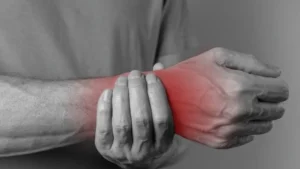Overview
Osteopenia is a condition characterized by low bone density, making individuals more susceptible to fractures. It is often considered a precursor to osteoporosis, a more severe condition. Osteopenia affects both men and women, particularly those above the age of 50, due to the natural decline of bone density that occurs with aging. While it is not a disease itself, it is a warning sign that requires attention and preventive measures to maintain long-term bone health.

Symptoms and Causes
In its early stages, osteopenia typically does not cause any noticeable symptoms. As the condition progresses, some individuals may experience a slight decrease in height or the development of stooped posture. Osteopenia is primarily caused by an imbalance between bone formation and bone resorption. Factors contributing to this imbalance can include a sedentary lifestyle, inadequate intake of bone-strengthening nutrients such as calcium and vitamin D, alcohol consumption, smoking, hormonal changes (such as low estrogen levels in women after menopause), certain medications, and underlying medical conditions.
Diagnosis and Tests
Osteopenia is diagnosed through bone density testing, typically using a dual-energy X-ray absorptiometry (DXA) scan. This painless and non-invasive procedure measures bone mineral density in specific areas, such as the hip or spine. The results of the scan are expressed as a T-score, comparing an individual’s bone density to that of a healthy young adult. A T-score between -1 and -2.5 indicates osteopenia, while a T-score of -2.5 or lower is indicative of osteoporosis. Regular screening, especially for individuals at higher risk, helps in early detection and intervention.
Management and Treatment
The management and treatment of osteopenia aim to prevent further bone loss, improve bone density, and reduce the risk of fractures. Lifestyle changes play a crucial role in this process. Regular weight-bearing exercises, such as walking, jogging, or weightlifting, help to strengthen bones. A balanced diet rich in calcium and vitamin D is essential for optimal bone health. Quitting smoking and limiting alcohol consumption are beneficial. In some cases, healthcare providers may recommend medication to increase bone density or address underlying medical conditions contributing to osteopenia.
Prevention
Prevention is key in maintaining bone health and reducing the risk of developing osteopenia or osteoporosis. Adequate intake of calcium and vitamin D through food sources or supplementation is crucial. Engaging in weight-bearing exercises regularly, particularly during adolescence and young adulthood, can help in optimizing bone density. Avoiding smoking and excessive alcohol consumption are important lifestyle choices. It is also advisable to have regular screenings for bone density, especially for individuals above the age of 50 or those with other risk factors.
Outlook / Prognosis
With early detection and proper management, the prognosis for individuals with osteopenia is generally positive. Making lifestyle modifications and adhering to recommended treatment plans can slow down the rate of bone loss and reduce the risk of fractures. However, it is essential to stay proactive and committed to long-term bone health. Regular monitoring, continued adherence to healthy habits, and timely adjustments in treatment, if required, can contribute to an improved outlook and a reduced risk of progressing to osteoporosis.
Frequently Asked Questions
1. Is osteopenia a serious condition?
Osteopenia is not a disease itself, but it is considered a warning sign of decreased bone density. Without proper preventive measures, it can progress to osteoporosis, increasing the risk of fractures. However, with early detection, lifestyle modifications, and medical intervention if necessary, osteopenia can be managed effectively.
2. Can osteopenia be reversed?
While it may not be possible to completely reverse osteopenia, early detection allows for effective management and the slowing down of bone loss. With lifestyle changes and, in some cases, medications, it is possible to improve bone density and reduce the risk of fractures.
3. Who is at risk of developing osteopenia?
Individuals above the age of 50, women after menopause, those with a family history of osteoporosis, individuals with low body weight or a history of fractures, and people with certain medical conditions or taking specific medications are at a higher risk of developing osteopenia. Regular screenings and lifestyle modifications are particularly important for this population to maintain optimal bone health.
4. Should I be concerned about osteopenia if I have no symptoms?
While osteopenia itself may not cause noticeable symptoms, it is still a concern as it increases the risk of fractures. Regular bone density screenings are recommended, especially for individuals at higher risk. Taking preventive measures, such as a healthy diet, weight-bearing exercises, and ensuring adequate calcium and vitamin D intake, can help maintain bone health even if symptoms are not present.